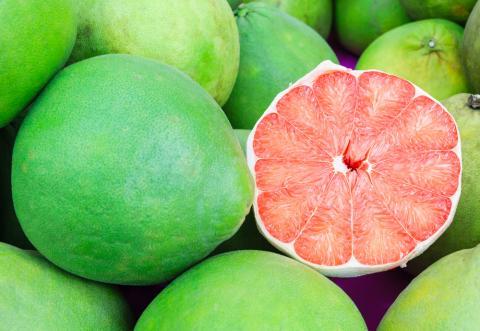
Pomelo is a member of the family Rutaceae, also known as the Rue family of the genus Citrus L., commonly called citrus P, that contains sixteen species. The fruit is also known as Chinese grapefruit, shaddock, pumelo, pommelo, and pompelmous. It is native to the southeastern regions of Asia and Malaysia and grows wild on the river banks in Fiji and Friendly Islands. It is said to have been introduced to China in the 1st century and was brought to the West Indies by Captain Shaddock, an English sea captain, in the 17th century.
The pomelo tree is a tropical plant that produces a fruit similar to grapefruit and is rich in nutrients, making it a healing herb for treating fevers, coughs, and gastrointestinal maladies. The aromatic flowers are used in Vietnam to make perfume and the wood of the tree is used to make handles for tools. Pomelo is rich in nutrients and has been used as an ingredient in salads, used in making candy, and as a medicinal herb.
Pomelo is the largest of the citrus fruits, growing on evergreen trees that range in height from sixteen to forty-nine feet in height. The tree produces flowers with a cream color that can grow in clusters or as a single bloom and range in diameter from one to two-and-one quarter inches. The leaves are the largest of citrus trees and the fruit is also the largest of the citrus family ranging in diameter from four to ten inches. It has a sweet flavor with large juice cells that can be pink or white. The rind is thick with a pink to yellow outer skin.
Health Benefits of Pomelo
The nutrients found in pomelo include vitamin C that contains a significant amount of antioxidants, folic acid in the form of folate, and dietary fiber. These substances make pomelo a holistic healing herb. Vitamin C and antioxidants inhibit the development of free radicals, which boosts the immune system by enhancing white blood cell activity, preventing colds, flu, and viruses. It also slows the aging process by keeping the skin moist and supple and lessening the incidents of age spots. It contains spermidine another antiaging chemical found in sperm.
Other health benefits of pomelo include maintaining a healthy digestive system due to its high fiber content. Fiber bulks the fecal matter and stimulates the production of digestive juices, resulting in the prevention of constipation. The potassium in pomelo regulates blood pressure by relieving the tension in the blood vessels, resulting in normal circulation, oxygenation of the organs, and easing the strain on the heart, preventing heart attacks and stroke.
How To Grow Pomelo
Pomelo is easy to grow and maintain. In the warmer climates, it can be added to the landscape and in the colder climates, it makes a nice container tree. The plant can be grown from seed but it will take eight years to produce fruit. It needs full sunlight and good draining soil and should be watered once a week. It is advised to keep the area around the tree free from grass, debris, and weeds; also fertilize the plant with citrus fertilizer.
The tree grows about twenty-four inches annually, maturing to a height of twenty-five feet with a life span that ranges from fifty to 150 years. As a container plant pomelo will not grow as large and can be easily pruned. It is important to use the correct container, one that is at least ten gallons and drains well. Find a spot with full sunlight and do not move it around so as not to stress the tree. It can be put out in the summer months on a deck, patio, or garden, but in the winter it should be brought inside in colder climates.
Ways To Eat Pomelo
Pomelo is a versatile food that can be prepared in many ways and can be eaten unprepared. It can be juiced, used in marmalade recipes, and added to beverages. Pomelos add a pleasant flavor to salads, desserts, and preserves. Their leaves are used to season meats and fish dishes and the dried leaves make a tasty tea. Pomelo essential oil is used as a flavoring in baked goods, candies, ice cream, and soft drinks. The juice is added to desserts and soups and the pulp is used for the preparation of jams, jellies, and syrups.








